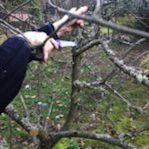Tips and Suggestions for Pruning Your Trees
Trees, especially when young and immature, will benefit significantly from regular pruning. Pruning is an essential tree care practice to help a tree grow properly while keeping it healthy. Below are the tips and suggestions to help you better prune your trees.
Why Prune Your Trees

There are multiple benefits of regularly pruning young trees as they develop their structure. Pruning is necessary for a number of reasons.
- Promote Healthy Growth - by pruning young trees you aid it in developing strong branches and a full structure. Eliminating weak or undesirable branches early in a tree's life enables it to focus growth the branches that will look better and help support its structure as it matures. Believe it or not, but regular pruning will actually generate more growth as the plant responses to the cutting. It will focus growth after the pruning on filling in and producing stronger desirable branches.
- Eliminate Dead Branches - winter kill in a young tree often produces dead branches that should be routinely eliminated. This will make the tree look better and enable the living branches to obtain more sunlight and be healthier. As the tree gets bigger, routine pruning can help the tree remain safe by cutting down branches that might damage property or life.
- Shaping - pruning can allow the property owner to better shape the tree to fit into its environment. Now with that said, you cannot prune to aggressively trying to shape a tree into an unnatural shape. If you do this, there is a strong likelihood that you will either kill the tree or permanently disfigure it. However, regular, sensible pruning can help a tree grow into a shape that is most desirable for your property and the landscape.
- Manage Flower Production - regular pruning can help the gardener control the level of flower production a tree has. This is a technique an arborist will use to help balance flower production with overall growth.
- Provide Clearance - pruning can help with clearance around and under the tree. Lower branches can be hazardous and should be cut off or back if they interfere with access or sight. Trees can easily block sidewalks, traffic lights/signs, etc becoming a hazard to pedestrians and motorists alike.
- Minimize Shade and Wind Resistance - regular pruning can help a tree avoid overshadowing other landscaping preventing it from growing. Lawns are particularly vulnerable to shade so regular pruning can help a tree and a lawn coexist. Additionally, pruning the canopy of a tree can help reduce its resistance to wind thereby helping to minimize the potential of damage from strong storms and ice.
When to Prune
Pruning is best done in late autumn or early winter. Trees will naturally be dormant then and any cuttings will not produce much or any sap flow. Further, the tree is bare of leaves making it much easier to see where to cut. Dead branches will be easy to identify despite the lack of leaves on the tree by just lightly scratched the branch. If the branch is dead there will be no green living tissue exposed. Further, the ground will be hard during these seasons reducing potential damage to your lawn, and, all landscape planting will be dead so there is no risk to damaging them.
For more information contact our tree service experts at the tree service Birmingham AL trusts.
For more information contact our tree service experts at the tree service Birmingham AL trusts.
